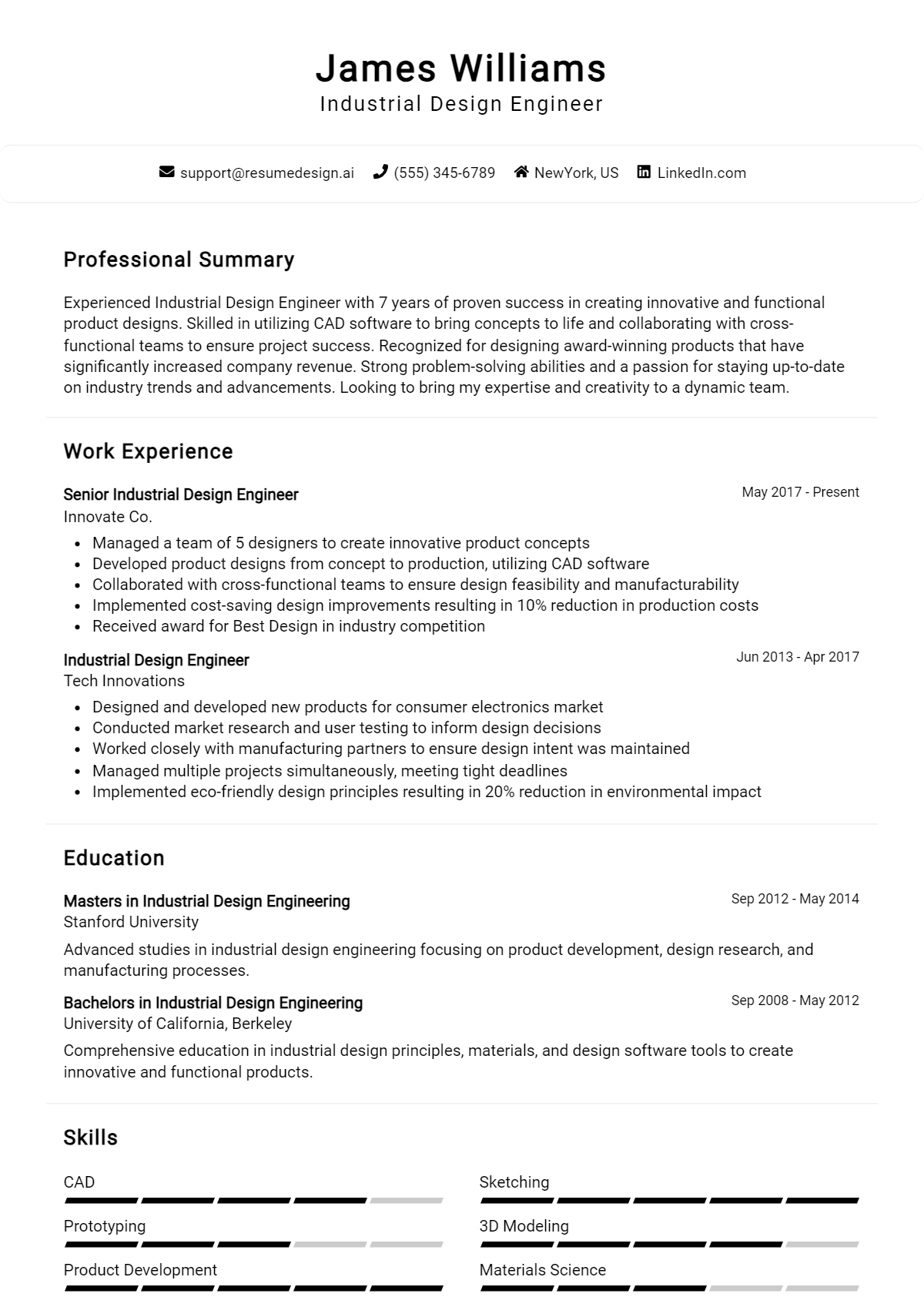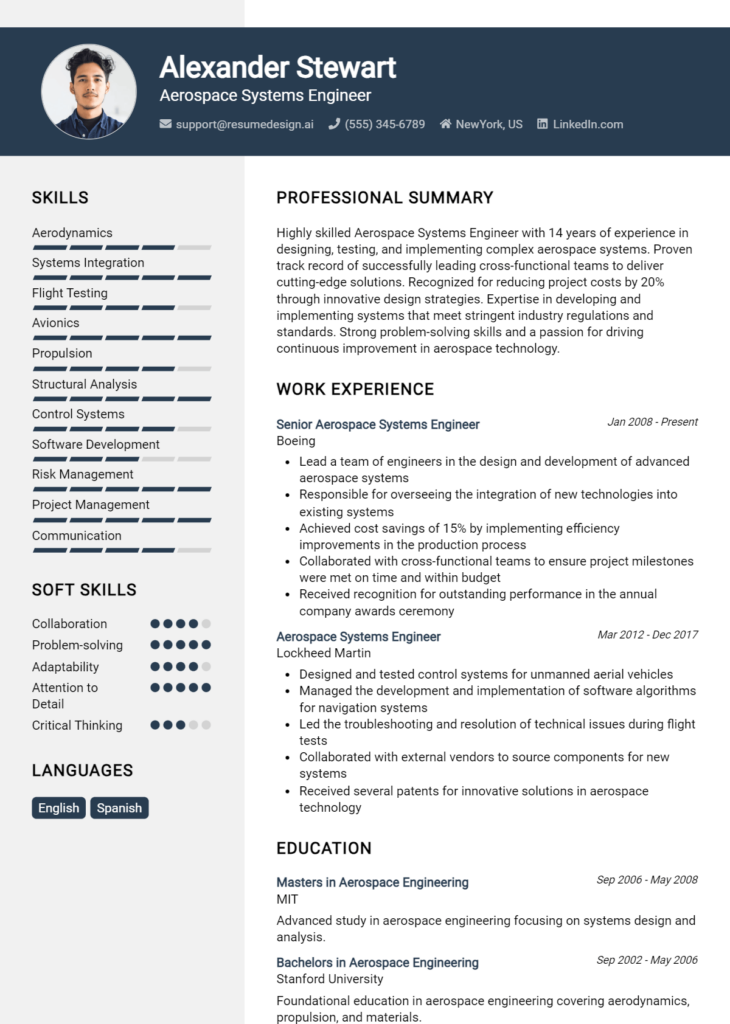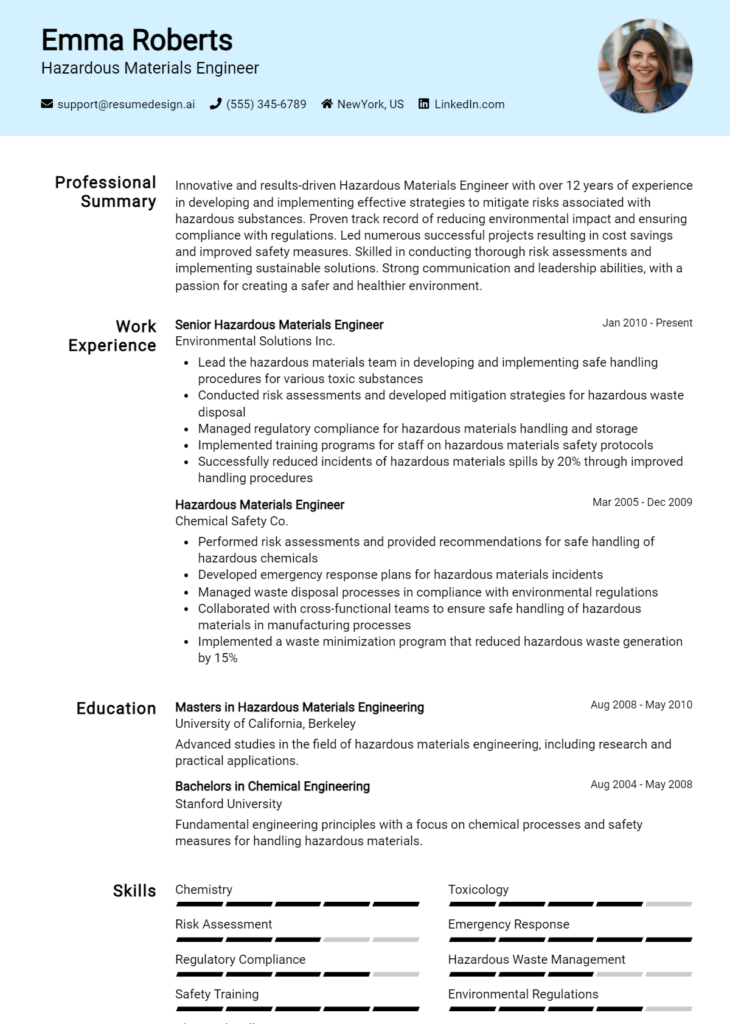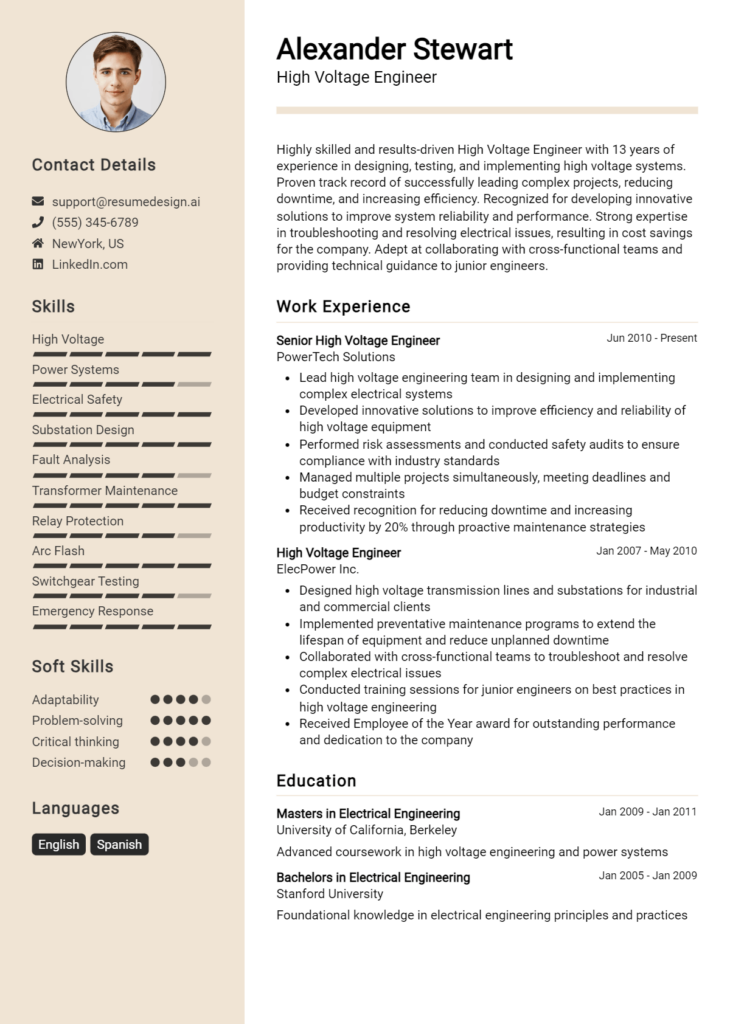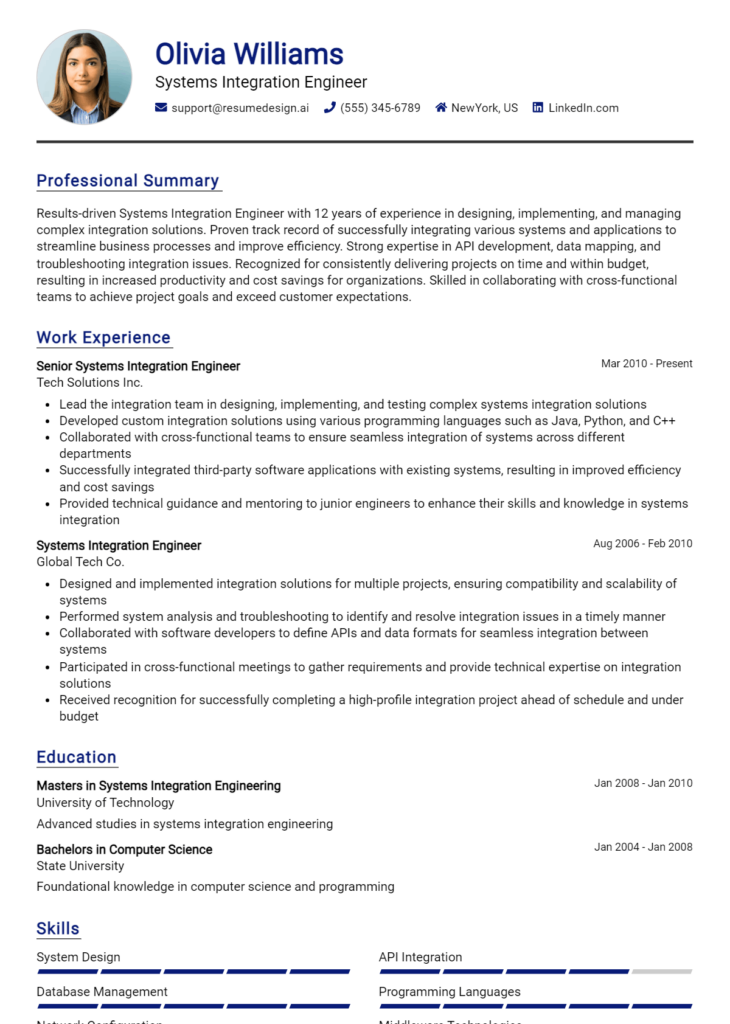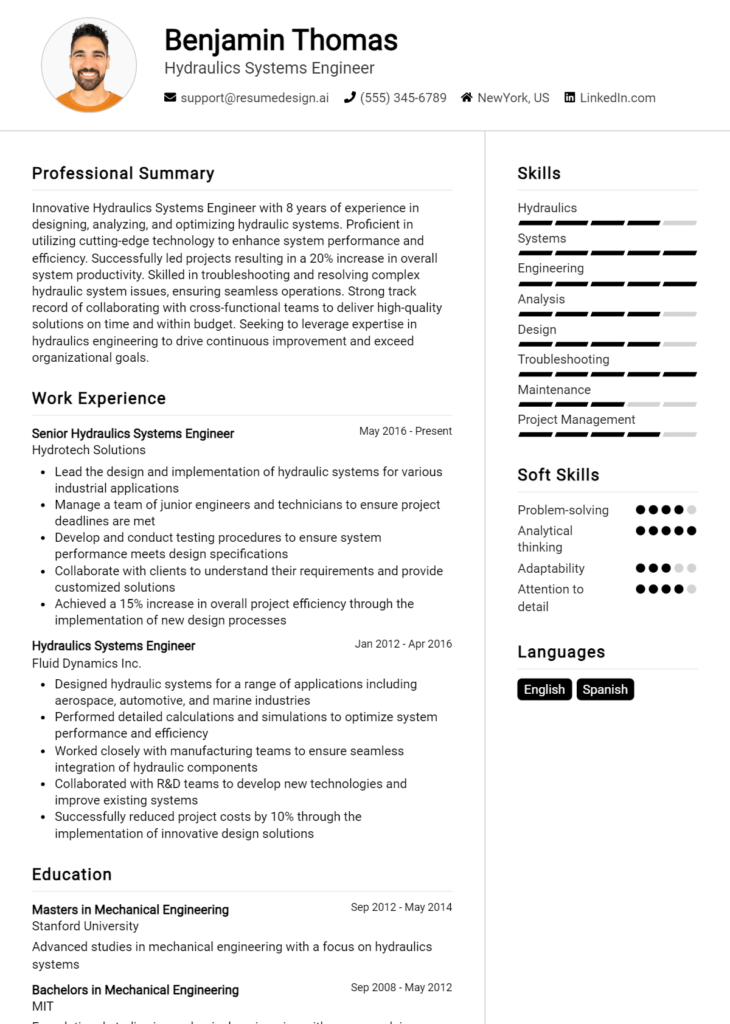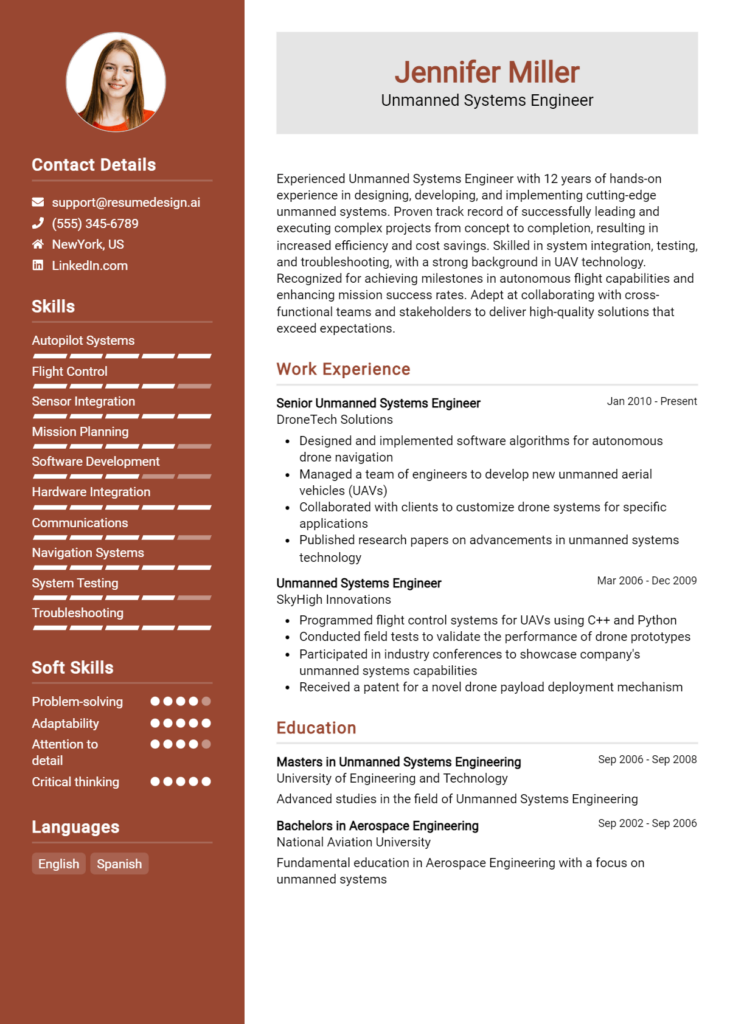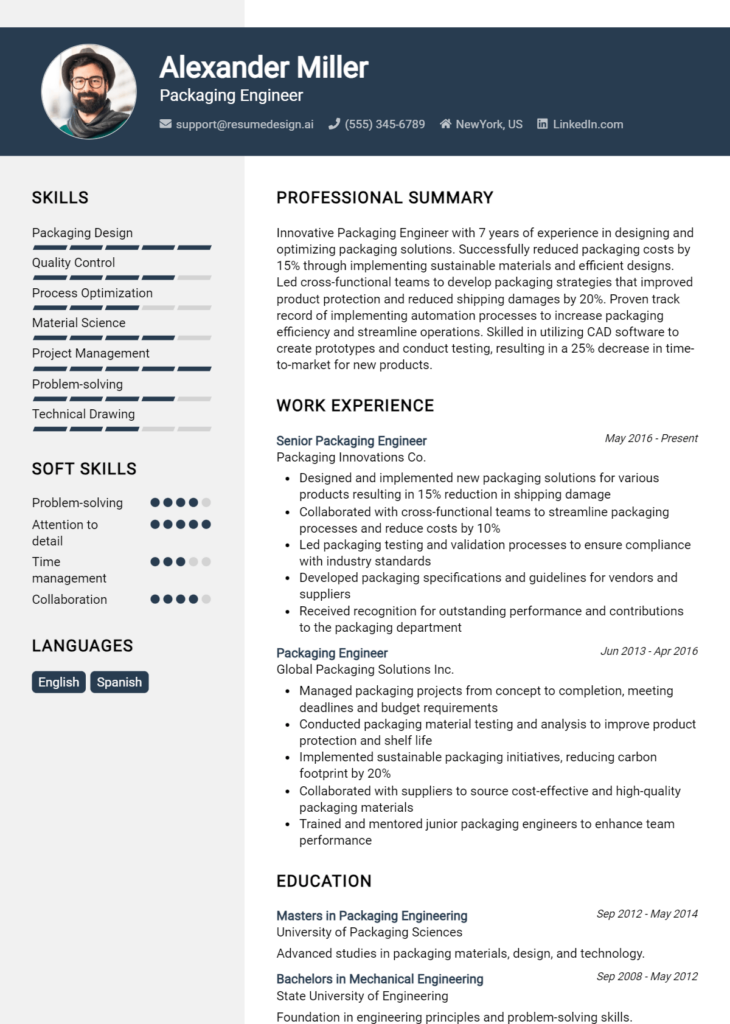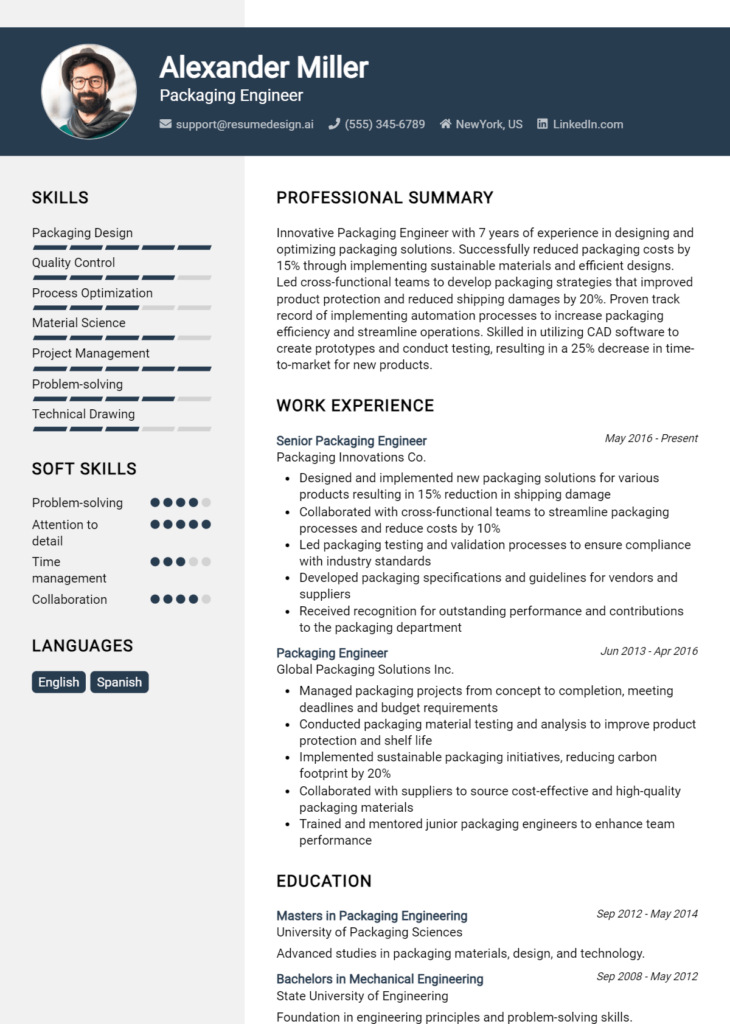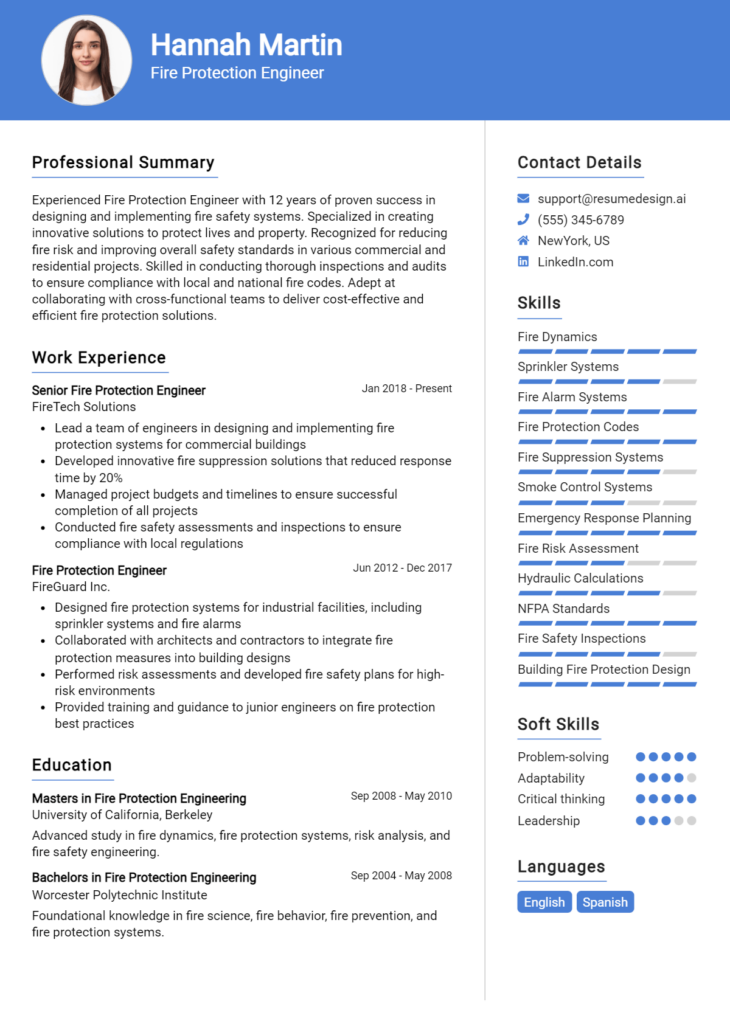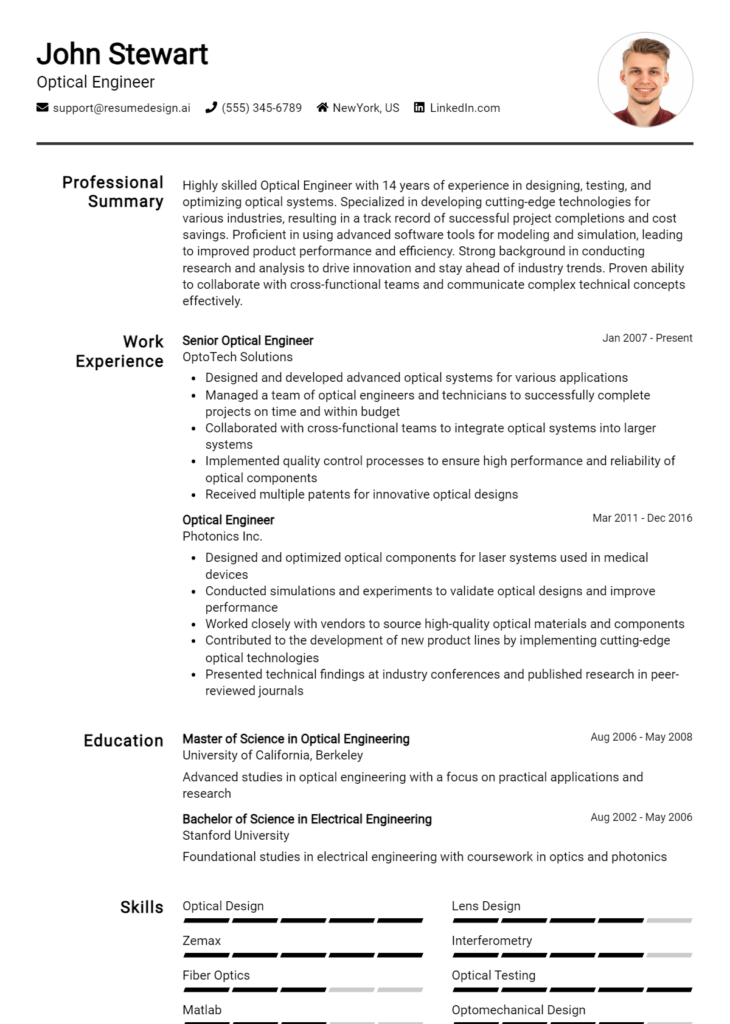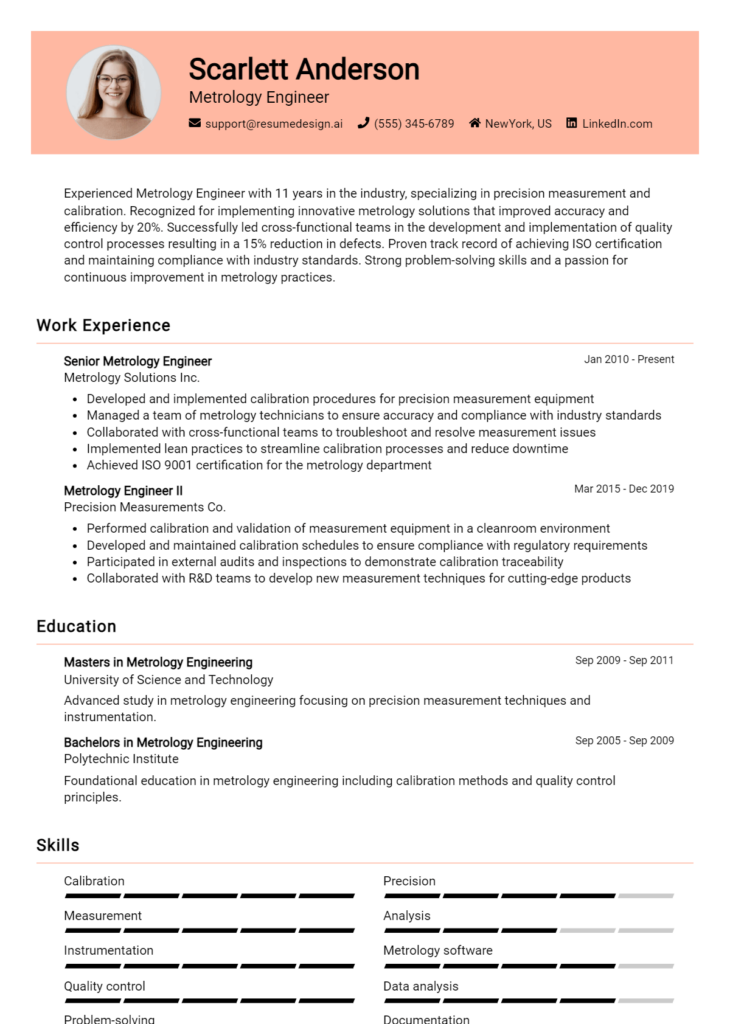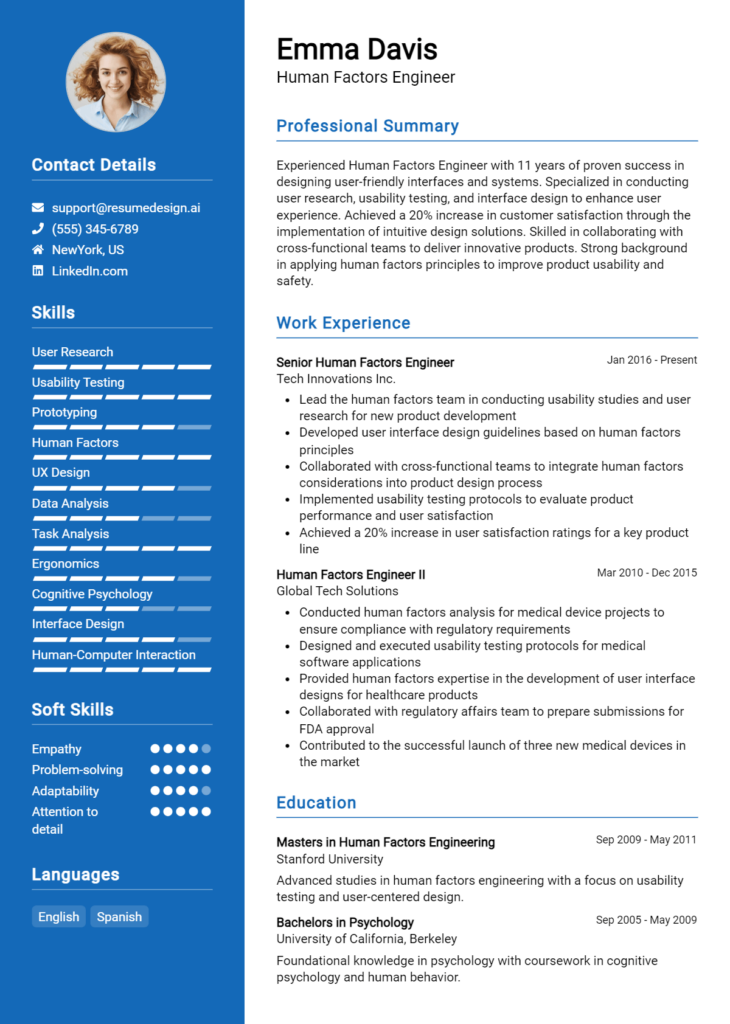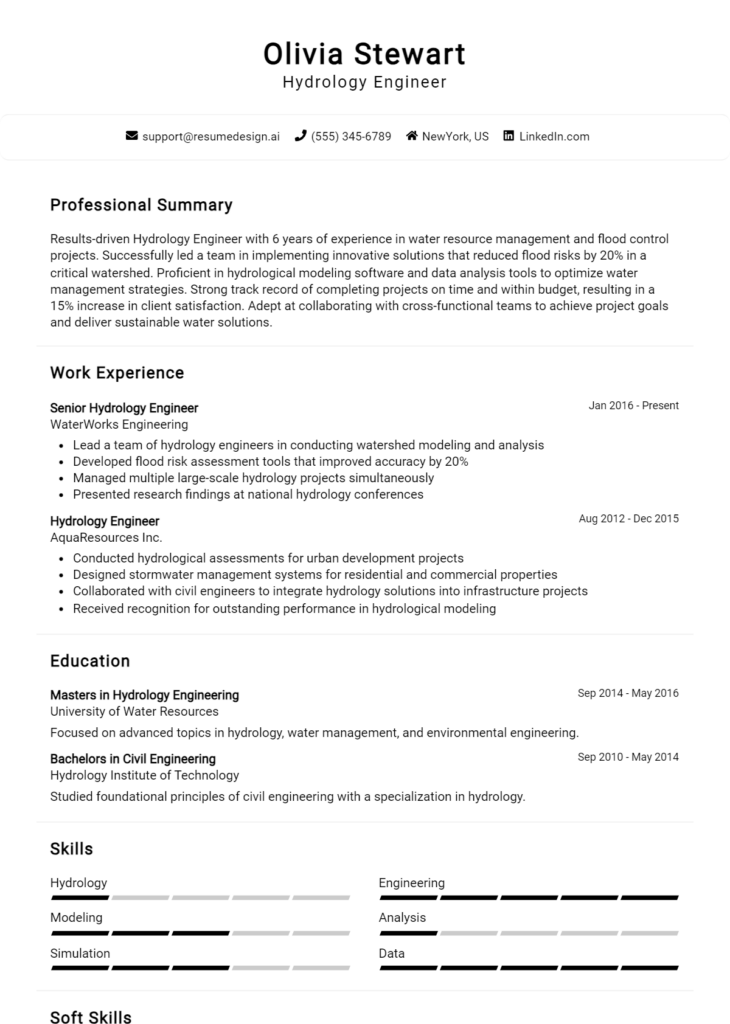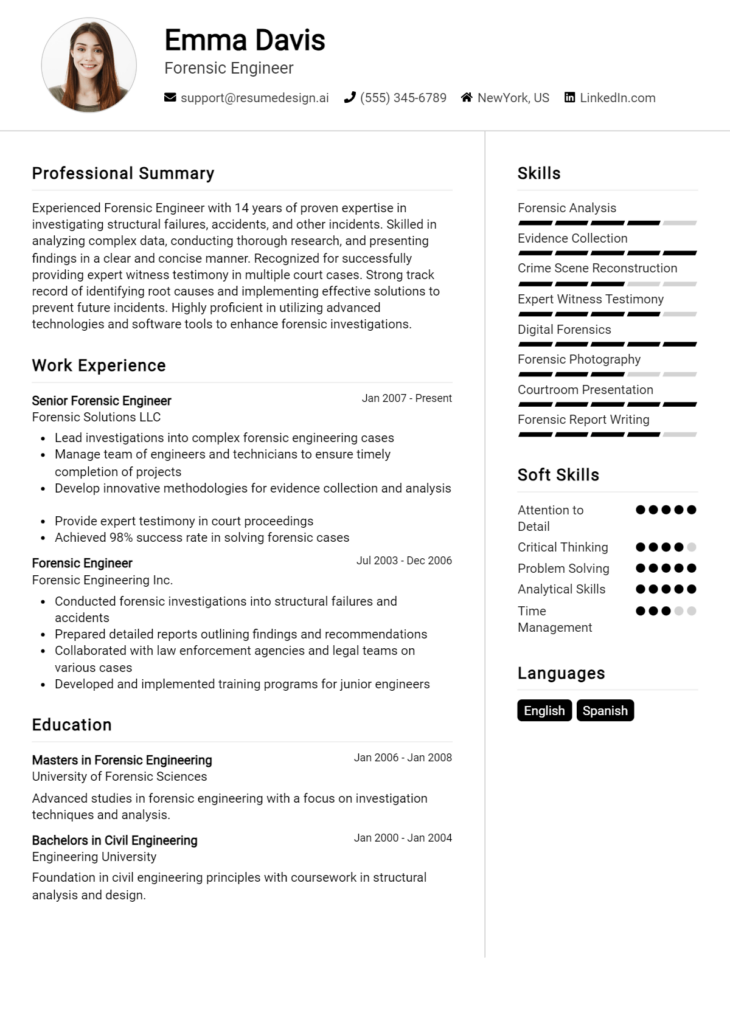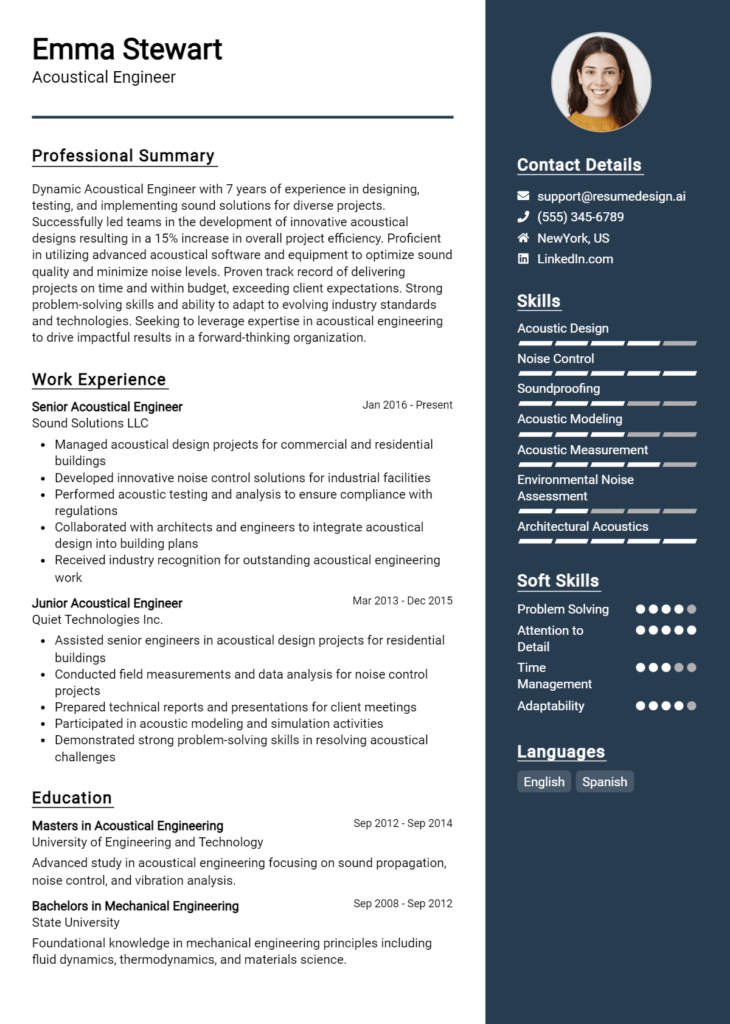Industrial Design Engineer Core Responsibilities
An Industrial Design Engineer plays a crucial role in bridging various departments such as engineering, marketing, and manufacturing. Key responsibilities include conceptualizing product designs, conducting user research, and creating prototypes. Essential skills involve technical proficiency in design software, operational understanding of production processes, and strong problem-solving abilities. These competencies contribute significantly to an organization’s innovation and efficiency. A well-structured resume effectively showcases these qualifications, highlighting the candidate’s potential to enhance product development and drive business success.
Common Responsibilities Listed on Industrial Design Engineer Resume
- Developing innovative product concepts and designs.
- Conducting market research and user analysis.
- Creating detailed design specifications and documentation.
- Collaborating with engineering and manufacturing teams.
- Prototyping and testing new designs for functionality.
- Utilizing CAD software for design modeling.
- Evaluating and selecting materials for production.
- Presenting design solutions to stakeholders.
- Ensuring compliance with industry standards and regulations.
- Managing project timelines and budgets effectively.
- Iterating on designs based on user feedback.
- Staying updated with design trends and technologies.
High-Level Resume Tips for Industrial Design Engineer Professionals
A well-crafted resume is a crucial tool for Industrial Design Engineer professionals, serving as the first impression a candidate makes on potential employers. In the competitive field of industrial design, where creativity and technical expertise are paramount, your resume must effectively showcase both your skills and achievements. A strong resume not only highlights your qualifications but also tells your unique story as a designer. This guide will provide practical and actionable resume tips specifically tailored for Industrial Design Engineer professionals, ensuring that your application stands out in a crowded job market.
Top Resume Tips for Industrial Design Engineer Professionals
- Tailor your resume to the job description by incorporating relevant keywords and phrases that match the specific role you are applying for.
- Showcase your relevant experience by emphasizing projects and roles that directly relate to industrial design, including internships and freelance work.
- Quantify your achievements by using metrics and numbers to illustrate the impact of your work, such as project timelines, budget management, and user satisfaction rates.
- Highlight industry-specific skills, including proficiency in design software (e.g., CAD, SolidWorks) and knowledge of manufacturing processes.
- Include a portfolio link showcasing your best design projects, demonstrating your capabilities and creative style.
- Use a clean, organized format with clear headings and bullet points to make your resume easy to read and navigate.
- Start bullet points with strong action verbs that convey your contributions, such as "designed," "developed," "collaborated," or "implemented."
- Incorporate relevant certifications or continuing education courses that reinforce your commitment to staying updated in the field.
- Keep your resume concise, ideally one page, focusing on the most pertinent information that reflects your qualifications.
By implementing these tips, Industrial Design Engineer professionals can significantly increase their chances of landing a job in their field. A well-structured and tailored resume not only highlights your unique skills and experiences but also communicates your professional narrative effectively, making you a compelling candidate for potential employers.
Why Resume Headlines & Titles are Important for Industrial Design Engineer
In the competitive field of industrial design engineering, a well-crafted resume headline or title serves as a crucial element in capturing the attention of hiring managers. It acts as the first impression for your application, summarizing your key qualifications and unique value proposition in a concise and impactful manner. A strong headline should be tailored to the specific job being applied for, ensuring relevance and clarity. By doing this, candidates can effectively communicate their strengths and experiences, making it easier for hiring managers to see how they align with the needs of the organization.
Best Practices for Crafting Resume Headlines for Industrial Design Engineer
- Keep it concise: Aim for a headline that is no longer than 10-12 words.
- Be role-specific: Use keywords related to industrial design engineering to enhance relevance.
- Highlight key strengths: Focus on your most significant skills, experiences, or accomplishments.
- Avoid jargon: Use clear and straightforward language to ensure accessibility.
- Use action-oriented language: Start with action verbs to convey dynamism.
- Tailor for each application: Customize your headline for every job you apply to.
- Include relevant certifications: If applicable, mention specific certifications that enhance your candidacy.
- Make it impactful: Choose words that evoke confidence and professionalism.
Example Resume Headlines for Industrial Design Engineer
Strong Resume Headlines
Innovative Industrial Design Engineer with 10+ Years of Experience in Sustainable Product Development
Creative Problem Solver Specializing in User-Centric Design and Prototyping
Award-Winning Industrial Designer with Expertise in CAD and Rapid Prototyping
Weak Resume Headlines
Experienced Engineer Looking for a Job
Industrial Design Engineer
The strong headlines are effective because they highlight specific skills, experiences, and accomplishments that are relevant to the industrial design engineering role, making the candidate stand out in a crowded field. They convey confidence and expertise, compelling hiring managers to read further. In contrast, the weak headlines fail to impress as they lack specificity and clarity, making it difficult for employers to ascertain the candidate's qualifications or interest in the position. By avoiding generic phrases, candidates can ensure their resumes make a memorable impact.
Writing an Exceptional Industrial Design Engineer Resume Summary
A resume summary is a crucial component for an Industrial Design Engineer, as it serves as the first impression a candidate makes on hiring managers. A well-crafted summary succinctly highlights key skills, relevant experience, and notable accomplishments, allowing candidates to stand out in a competitive job market. In a matter of seconds, a strong summary can capture the attention of hiring managers and encourage them to read further. It should be concise, impactful, and specifically tailored to the job description, ensuring that it aligns with the needs of the potential employer.
Best Practices for Writing an Industrial Design Engineer Resume Summary
- Quantify achievements: Use specific numbers or metrics to demonstrate your impact.
- Focus on relevant skills: Highlight technical skills and soft skills that are pertinent to the job.
- Tailor the summary: Customize the summary for each job application to align with the job description.
- Keep it concise: Aim for 2-4 sentences that deliver a clear message without unnecessary detail.
- Showcase industry knowledge: Include terms or concepts that reflect your understanding of the industry.
- Use action verbs: Start sentences with strong action verbs to convey confidence and proactivity.
- Highlight problem-solving abilities: Mention your capacity to address challenges and improve processes.
- Demonstrate creativity: As a designer, emphasize your innovative approach and creative thinking.
Example Industrial Design Engineer Resume Summaries
Strong Resume Summaries
Results-driven Industrial Design Engineer with over 7 years of experience in product development, achieving a 30% reduction in production costs through innovative design solutions. Proficient in CAD software and rapid prototyping, with a strong focus on user-centered design principles.
Creative Industrial Design Engineer with a proven track record of launching 15+ successful consumer products, resulting in a 50% increase in market share for previous employers. Skilled in integrating sustainable materials into design processes and enhancing product functionality.
Detail-oriented Industrial Design Engineer who led a cross-functional team that developed a groundbreaking ergonomic tool, increasing user satisfaction ratings by over 40%. Expertise in 3D modeling and design validation, with a passion for enhancing user experience.
Weak Resume Summaries
Industrial Design Engineer with some experience in design projects. Looking for a new opportunity to apply skills.
Creative designer who is seeking a role in industrial design. Enjoys working on various projects and collaborating with teams.
The strong resume summaries are considered effective because they provide specific, quantifiable achievements and demonstrate a clear alignment with the role of an Industrial Design Engineer. They highlight relevant skills and experiences that directly relate to the job, showcasing the candidate's value to potential employers. In contrast, the weak summaries lack detail and specificity, failing to convey the candidate's unique qualifications or measurable successes, which diminishes their impact in a competitive job market.
Work Experience Section for Industrial Design Engineer Resume
The work experience section of an Industrial Design Engineer resume is vital as it serves as a comprehensive showcase of a candidate's technical skills and industry-specific expertise. This section enables potential employers to evaluate the applicant's ability to manage teams, coordinate projects, and deliver high-quality products that meet rigorous design standards. By quantifying achievements, such as project successes or efficiency improvements, candidates can demonstrate their value effectively. Aligning work experiences with industry standards and expectations further emphasizes the candidate's fit for the role, making this section crucial for standing out in a competitive job market.
Best Practices for Industrial Design Engineer Work Experience
- Highlight specific projects that demonstrate your design process and outcomes.
- Quantify results with metrics, such as cost savings, time reductions, or user satisfaction improvements.
- Emphasize collaboration with cross-functional teams and stakeholders.
- Detail your technical skills, including software tools and methodologies used in design.
- Showcase leadership roles and responsibilities within projects.
- Align your work experience with the skills and qualifications listed in the job description.
- Use action verbs to convey your contributions and impact effectively.
- Include any awards or recognitions received for your design work.
Example Work Experiences for Industrial Design Engineer
Strong Experiences
- Led a team of 5 in the redesign of a consumer electronics product, resulting in a 30% increase in user satisfaction ratings and a 15% decrease in manufacturing costs.
- Developed a new design process that reduced project timelines by 25%, enabling the launch of three new products within a fiscal year.
- Collaborated with marketing and engineering teams to deliver an award-winning product, which generated $2 million in revenue within the first six months of launch.
- Implemented user-centered design principles in the development of a medical device, leading to improved usability scores by 40% during user testing.
Weak Experiences
- Worked on various projects in the design department.
- Assisted in the development of products and attended meetings.
- Participated in design reviews without specifying contributions.
- Involved in team discussions regarding product improvements.
The examples categorized as strong reflect specific, quantifiable achievements that showcase the candidate's technical expertise and leadership skills. They demonstrate a clear impact on project outcomes and collaboration with other teams, making them compelling to potential employers. Conversely, the weak experiences lack detail and quantifiable results, providing little insight into the candidate's actual contributions or capabilities, which diminishes their effectiveness in a competitive job market.
Education and Certifications Section for Industrial Design Engineer Resume
The education and certifications section of an Industrial Design Engineer resume is crucial for demonstrating the candidate's academic qualifications and commitment to professional development. This section showcases relevant degrees, industry-recognized certifications, and specialized training that align with the demands of the role. By highlighting pertinent coursework and certifications, candidates can enhance their credibility and illustrate their dedication to continuous learning, making them stand out to potential employers in a competitive job market.
Best Practices for Industrial Design Engineer Education and Certifications
- Include only relevant degrees and certifications that align with industrial design principles.
- List the most recent educational experiences first, including graduation dates, to emphasize current knowledge.
- Highlight advanced degrees (Masters or Ph.D.) or specialized certifications that enhance your qualifications.
- Provide specific coursework that relates directly to industrial design, such as product development, materials science, or ergonomics.
- Consider including online courses or workshops from reputable organizations to demonstrate ongoing education.
- Clearly label your certifications and indicate if they are accredited by recognized industry bodies.
- Use bullet points for clarity and to make it easy for hiring managers to scan your qualifications.
- Keep this section concise while ensuring it reflects your strongest qualifications.
Example Education and Certifications for Industrial Design Engineer
Strong Examples
- Bachelor of Science in Industrial Design, University of California, Berkeley, 2022
- Certified Industrial Designer (CID), Industrial Designers Society of America, 2023
- Advanced Certificate in Product Development, Stanford University Online, 2023
- Relevant Coursework: User-Centered Design, Sustainable Materials, 3D Modeling and Prototyping
Weak Examples
- Bachelor of Arts in History, State University, 2015
- Certification in Microsoft Office Suite, 2020
- Diploma in Graphic Design from a non-accredited institution, 2019
- Relevant Coursework: Introduction to Psychology, 2016
The examples provided illustrate a clear distinction between strong and weak educational qualifications and certifications. Strong examples are directly relevant to the field of industrial design, showcasing applicable degrees and certifications that reflect current industry standards. Conversely, weak examples demonstrate a lack of relevance to the role; they include outdated or unrelated education and certifications that do not support the candidate's suitability for an Industrial Design Engineer position. This highlights the importance of tailoring the education and certifications section to align with the job requirements and industry expectations.
Top Skills & Keywords for Industrial Design Engineer Resume
As an Industrial Design Engineer, showcasing the right skills on your resume is crucial to stand out in a competitive job market. Employers seek candidates who not only possess the technical expertise to design and innovate but also exhibit the interpersonal qualities that foster teamwork and collaboration. A well-crafted resume that highlights both hard and soft skills can significantly enhance your chances of landing an interview. By effectively communicating your abilities, you can demonstrate your potential to contribute to a company's success.
Top Hard & Soft Skills for Industrial Design Engineer
Soft Skills
- Creative Problem Solving
- Team Collaboration
- Communication Skills
- Time Management
- Attention to Detail
- Adaptability
- Critical Thinking
- User-Centered Design Approach
- Project Management
- Interpersonal Skills
- Empathy in Design
- Negotiation Skills
- Conflict Resolution
- Presentation Skills
Hard Skills
- CAD Software Proficiency (e.g., SolidWorks, AutoCAD)
- 3D Modeling and Rendering
- Prototyping Techniques
- Material Selection and Analysis
- Ergonomics and Human Factors
- Design for Manufacturing (DFM)
- Product Lifecycle Management (PLM)
- Technical Drawing and Specifications
- Rapid Prototyping Technologies (e.g., 3D Printing)
- Knowledge of Manufacturing Processes
- User Interface (UI) Design
- Research and Development Methodologies
- Sustainability and Eco-Design Principles
- Quality Assurance and Testing Procedures
For more insights on skills and how to effectively present your work experience, consider tailoring your resume to highlight these essential abilities, ensuring you make a strong impression on potential employers.
Stand Out with a Winning Industrial Design Engineer Cover Letter
As an accomplished Industrial Design Engineer with over five years of experience in the field, I am excited to apply for the position at [Company Name]. My background in product development, coupled with my passion for innovative design, has equipped me with the skills necessary to contribute significantly to your team. At [Previous Company Name], I led a cross-functional team in the design and development of a sustainable consumer product that not only met market demands but also garnered recognition for its eco-friendly approach. I am eager to bring this same level of dedication and creativity to [Company Name].
Throughout my career, I have honed my abilities in 3D modeling, prototyping, and user-centered design. My proficiency in various design software, including SolidWorks and Adobe Creative Suite, has allowed me to translate complex ideas into tangible solutions efficiently. I believe that collaboration is key to successful design, and I thrive in environments where I can work closely with engineers, marketers, and end-users to ensure that the final product aligns with both aesthetic and functional requirements. My role in the recent redesign of a household appliance not only improved its usability but also increased sales by 20% within the first quarter of its launch.
I am particularly drawn to [Company Name] because of its commitment to pushing the boundaries of design and technology. I am impressed by your recent projects, such as [specific project or initiative], which resonate with my belief in creating products that enhance user experience while being mindful of sustainability. I am eager to leverage my experience in user research and iterative design processes to contribute to innovative solutions that align with your mission and values.
Thank you for considering my application. I look forward to the opportunity to discuss how my skills and experiences align with the needs of your team. I am excited about the possibility of contributing to [Company Name] and am confident that my passion for industrial design will make a positive impact on your projects.
Common Mistakes to Avoid in a Industrial Design Engineer Resume
When crafting a resume for an Industrial Design Engineer position, it's crucial to present a polished and professional image that effectively showcases your skills and experience. However, many applicants make common mistakes that can detract from their qualifications and diminish their chances of securing an interview. By being aware of these pitfalls, you can enhance your resume and make a strong impression on potential employers.
Neglecting Tailoring: Failing to customize your resume for each job application can make it seem generic. Highlight relevant skills and experiences that align with the specific requirements of the role.
Overloading with Technical Jargon: While it's important to demonstrate technical knowledge, using too much industry jargon can alienate hiring managers who may not be familiar with all the terms. Aim for clarity and balance.
Ignoring Visual Design Principles: As an industrial designer, your resume should reflect your design sensibility. Avoid cluttered layouts and ensure your resume is visually appealing and easy to read.
Listing Duties Instead of Achievements: Simply listing job responsibilities does not convey your impact. Focus on quantifiable achievements that showcase your contributions and results in previous roles.
Omitting Soft Skills: Industrial design also requires strong collaboration and communication skills. Neglecting to include these can give a narrow view of your capabilities.
Using Passive Language: Phrasing your accomplishments in a passive voice can weaken your statements. Use active language to convey ownership of your achievements and initiatives.
Inconsistent Formatting: Inconsistencies in font, spacing, and alignment can make your resume appear unprofessional. Maintain uniform formatting throughout to enhance readability and professionalism.
Excessive Length: A resume that is too long can overwhelm recruiters. Aim for a one-page format or two pages at most, ensuring that every detail included is relevant and impactful.
Conclusion
As an Industrial Design Engineer, your role is crucial in creating innovative products that are not only functional but also aesthetically pleasing. Throughout this article, we explored the essential skills and qualifications needed for success in this field, including proficiency in CAD software, a strong understanding of materials and manufacturing processes, and an ability to work collaboratively within multidisciplinary teams. We also discussed the importance of keeping up with industry trends and continuously enhancing your design portfolio.
To ensure you stand out in your job applications, it's vital to have a well-structured and compelling resume that highlights your unique skills and experiences. Take a moment to review your Industrial Design Engineer resume and ensure it reflects your capabilities and accomplishments effectively.
For those looking to enhance their resumes, a variety of resources are available to assist you. You can access professionally designed resume templates to create a polished layout, use a resume builder for an easy and guided creation process, explore resume examples for inspiration, and check out cover letter templates to complement your application.
Take action today—revamp your resume and position yourself as a top candidate in the competitive field of industrial design engineering!

